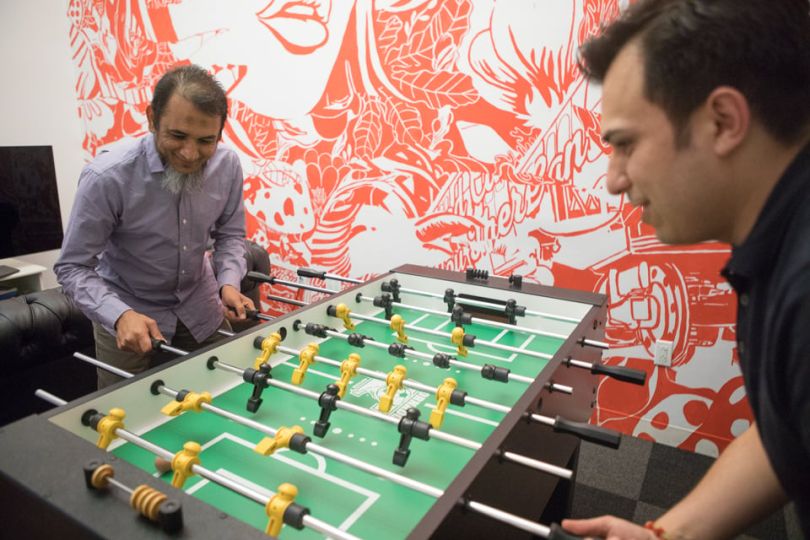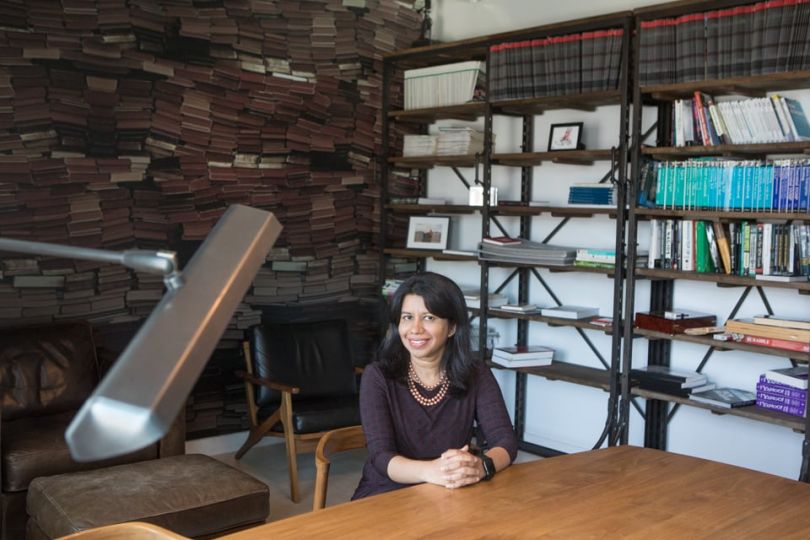
Directors of engineering Rashi Khurana and Sultan Mahmood are no strangers to big brands. Hailing from Expedia and HBO, respectively, they now head up two engineering teams at Shutterstock — a company with comparable name recognition.
Though Shutterstock is made up of 900 employees worldwide and provides global creative teams with striking imagery, it still operates like a startup. It's that balancing act that gives engineers the ability to directly influence the company’s success.
Khurana and Mahmood sat down with us to explain what it’s like to lead innovation in content.



FOUNDED: 2003.
EMPLOYEES: 900 people across the globe.
WHAT THEY DO: Provide creatives with an online marketplace for content, including photos, videos and music.
WHERE THEY DO IT: On a few floors high up in the Empire State Building.
WHO FOR: Editors, marketers and designers all over the world.
IDEAL CANDIDATE: Experts who are passionate and eager to work collaboratively.
NOT ONE BUT TWO: Outdoor patios overlooking Manhattan.
FIXED IT: When engineers learned Shutterstock's watermarks were vulnerable to copyright infringement, the team devised a solution. Read about it below.

What attracted you to Shutterstock?
Rashi Khurana, director of engineering: I love working with nice aesthetics. Before Shutterstock, I worked at Orbitz Worldwide (now Expedia) for seven and a half years, where I got to look at beautiful travel photos while I worked. Even when you're doing major testing, you're looking at these beautiful pictures all day.
Sultan Mahmood, director of engineering, content: I was originally attracted to Shutterstock’s great balance of being somewhere in between a mature organization and a startup. It's right in the middle — and that’s where you can really lead big innovation and transformation.
I was originally attracted to Shutterstock’s great balance of being somewhere in between a mature organization and a startup."
How have you seen the company transform?
Mahmood: The company has grown tremendously since it started — particularly in a horizontal direction. When the solution was first built at that time, it wasn’t necessarily prepared for this scale. I started earlier this year, and I’ve already worked on a number of projects that help with scale.
The company has grown tremendously since it started — particularly in a horizontal direction."
Khurana: I started in November 2015, and have seen our tech stack transform from an outdated technology to Node.js, which is what many other startups are doing today.


What are each of your team’s responsibilities?
Khurana: My team members are responsible for delivering a healthy Shutterstock.com website. The most important part of my team's day-to-day is to make sure that the site is available, fast and responsive.
Mahmood: It's exactly what Rashi said. But while her team is on the front end, mine is on the back end, rebuilding the next generation for content ingestion pipeline. My team makes sure that each and every piece of the content supply chain is scalable — and we work closely together to make that happen.
How do you encourage collaboration with your teams?
Khurana: From a business perspective, Sultan and I like to step back and split a project into phases. From there, we offer one person from each of our teams who can sit together and build out each phase. When you put great minds together and create a mini team devoted to a project, you can move faster. From more of a recreational perspective, we often hold happy hours and encourage our teams to celebrate all of their hard work.
When you put great minds together and create a mini team devoted to a project, you can move faster."
Mahmood: We also have recurring hackathons, which are a great way for our teams to stay creative and inspired. When talent from different departments work together, the best ideas happen. Shutterstock Tab, a Chrome plugin that lets you see an image of one our contributors every time you open a new tab, was created as a result of a company-wide hackathon.
What are some major projects your team has worked on?
Mahmood: One of our big projects was changing the watermarks on our database of 151 million images. With all of the advancements in machine learning, it was becoming possible for a computer to remove repetitive watermarks and, in turn, infringe copyright. The team found a solution: use a slightly different watermark on each image. We began rolling it out to our whole library.
Khurana: Another big project was changing our engineering architecture. Two years ago, we broke our engineering team into smaller groups so there were domain experts — for example, there's a licensing team, a subscription team, a commerce team and so on. From there, we had to build a robust API, as well as a platform that would allow the teams to share knowledge. Doing so allows us to move faster as a company.

What’s the most challenging part of your job?
Mahmood: We’re working on so many projects at once, but probably the most challenging part is making sure that, while we execute all of these initiatives, we’re not losing sight of the bigger picture. We need to continue to operate in two streams; stream one focuses on maintenance and operations of our current business, while stream two focuses on strategic goals to innovate for future business needs.
Khurana: I agree. It's the balancing act of being involved in the day-to-day activities and still keeping your eyes on the end goal. It's like driving a car: your eyes have to be on the road, but you also have to watch your GPS and make sure you get where you need to be on time.
It's like driving a car: your eyes have to be on the road, but you also have to watch your GPS and make sure you get where you need to be on time.
Why would an engineer want to work at Shutterstock?
Khurana: For one, engineers are working on cutting-edge technology. We don’t use technologies of the past — we’re working on tools that you're actually shaping the world with. Another great thing about Shutterstock is that hard work is rewarded on an individual basis — nobody is graded on a curve. Rewards are never rationed. If you do well, you get recognized for it.

What do you look for when you’re hiring engineers?
Mahmood: I think in the neo-modern work environment, teamwork is much more important than anything else. Individual expertise is a given — of course we need somebody who can code and design. But you can only succeed with collaboration. Many companies have teams sitting in different cities all over the world, so being able to stay flexible in your methodology and open to feedback is highly important.
Khurana: I look for passion. I don't care what technology background you have. If you're smart, I trust that you'll pick it up. Having that passion to learn and grow is what makes someone a great engineer on my team — and that’s not something that can be taught.




